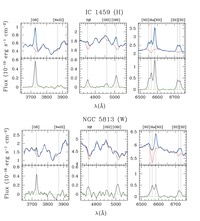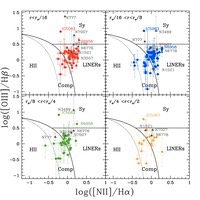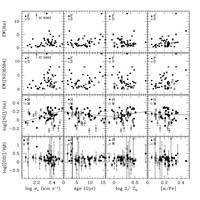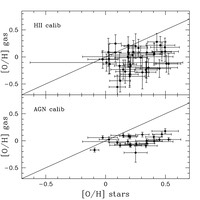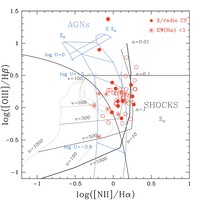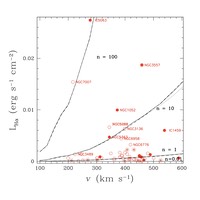Despite the number of studies about the ISM in ETGs, several issues remain still open. The first question is the origin of the ISM in ETGs. Narrow band imaging centered around Ha+[NII]6584 shows that the ionized gas presents a variety of morphologies, from regular, disk-like structures, to filamentary structures (Demoulin-Ulrich et al. (1984}; Buson et al. 1993; Macchetto et al. 1996; Zeilinger et al. 1996; Martel et al. 2004; Sarzi et al. 2006). Evidence for the acquisition of external gas comes from kinematical studies showing that the angular momentum of the gas is often decoupled from that of the stars (Bertola et al. 1992; van Dokkum & Franx 1995; Caon et al. 2000), even if according to Sarzi et al. (2006) the angular momenta are inconsistent with a purely external origin for the gas. The fact that the ionized gas emission is always associated with dust (e.g. Tran et al. 2001) tends to exclude ``cooling flows'' as the origin for the warm gas in E/S0 galaxies (Goudfrooij 1999). In the scenario proposed by Sparks et al. (1989) and de Jong et al. (1990), the dusty filaments can arise from the interaction of a small gas rich galaxy with the giant elliptical, or from a tidal accretion event in which the gas and dust are stripped from a passing spiral (see e.g. Domingue et al. 2003; Tal et al. 2009).
The history of star formation and evolution leaves its chemical signature in the ISM of ETGs. Historically, X-ray abundance measurements of the hot ISM have been problematic, as typified by the so-called Fe discrepancy (Arimoto et al. 1997). More recently, Chandra and XMM measurements of X-ray bright galaxies at the center of groups have supported roughly solar or even slightly supersolar abundances for the ISM (e.g. Gastaldello & Molendi 2002; Buote et al. 2003; Tamura et al. 2003), and have claimed no evidence for very subsolar Fe abundances (Humphrey & Buote 2006; Ji et al. 2009). These studies also report anomalously low oxygen abundances compared to iron and magnesium. This is in conflict with results from SN stellar yields if one assumes that the source of ISM is the material injected into interstellar space by evolved stars. Up to now, the only study of metallicity in the warm ISM is that of Athey & Bregman (2009), who derived oxygen abundances for seven ETGs from optical emission lines. The authors find an average solar metallicity, favoring an internal origin of the warm ISM. However, this study is limited by the small sample. Determining the metallicity of the warm ISM is fundamental to create a link between the hot gas phase and the galaxy stellar population, and to discriminate between an internal and an external origin of the interstellar matter in E/S0 galaxies.
The second still open issue concerns the ionizing source of the warm gas. Optical spectroscopic studies show that ETGs are typically classified as LINERs (Low-Ionization Nuclear Emission-line Regions, Heckman (1980) according to their emission line ratios (e.g. Phillips et al. 1986; Yan et al. 2006). However, there is still strong debate about the ionization mechanism in LINERs. At present, the most viable excitation mechanisms are: a low accretion-rate AGN (e.g., Ho 1999; Kewley et al. 2006, Ho 1999), photoionization by old post-asymptotic giant branch (PAGB) stars (e.g. Trinchieri & di Serego Alighieri 1991; Binette et al. 1994; Stasinska et al. 2008), fast shocks (Koski & Osterbrock 1976; Heckman 1980; Dopita & Sutherland 1995; Allen et al. 2008). The AGN mechanism is strongly supported by the detection of broad emission lines in optical spectra (e.g. Ho et al. 1997; Wang & Wei 2008), by the properties of the X-ray emission (Terashima et al. 2002; Flohic et al. 2006; Gonzalez-Martin et al. 2009), by the presence of UV and X-ray variability (e.g Maoz et al. 2005, Pian et al. 2010), and by the evidence that massive black holes (BHs) appear to be a generic component of galaxies with a bulge (Magorrian et al. 1998; Ho 1999; Kormendy 2004).
PAGB stars are good candidates because their radiation, much harder than that from young stars, is able to reproduce the observed emission-line ratios in LINERs (Trinchieri & di Serego Alighieri 1991; Binette et al. 1994; Stasinska et al. 2008). The most compelling evidence in support of the PAGB mechanism is the finding that the emission-line flux correlates very well with the host galaxy stellar luminosity within the emission-line region (Macchetto et al. 1996), and that the emission-line flux distribution follows that of the stellar continuum (Sarzi et al. 2006;2010). These correlations suggest that the source of ionizing photons is distributed in the same way as the stellar population. LINERs emission has also been observed in extranuclear regions associated with large-scale outflows and related shocks (Lipari et al. 2004), or regions shocked by radio jets (Cecil et al. 2000). Evidence is growing that more than one mechanism may be at work in LINERs. In a recent study, Sarzi et al. (2010) showed that the role of AGN activity is confined to the central regions, whereas at larger radii the stellar and nebular fluxes follow each other, thus suggesting a stellar ionizing source. Eracleous et al. (2010) showed that low accretion-rate AGNs do not produce enough ionizing photons to explain the observed Ha luminosities within a 2"x4'' aperture, so that other mechanisms are needed.
With the aim of understanding the formation history of ETGs, and the connection between the stellar populations and the ionized gas, we have analyzed intermediate-resolution optical spectra for a sample of 65 field E/S0 galaxies biased toward the presence of ISM emission. The stellar population properties (i.e. ages, metallicities, and elements abundance ratios) were derived at different radii in Annibali et al. (2007) through the analysis of the Lick indices. We present here the study of the optical emission lines in annuli of increasing galacto-centric distance. The purpose is to characterize the properties of the ionized gas, its origin, and the possible excitation mechanisms at different radii.
Optical emission lines are detected in 89% of the sample. The detection fraction drops to 57% if only the galaxies with EW(Ha+[NII])$>3 Angstrom are considered. The incidence and strength of emission do not correlate either with the E/S0 classification, or with the fast/slow rotator classification. Comparing the nuclear r<re/16 emission with the classical [OIII]/Hb vs [NII]/Ha diagnostic diagram, the galaxy activity is so classified: 72% of the galaxies with emission are LINERs, 9% are Seyferts, 12% are Composite/Transition objects, and 7% are non-classified. Seyferts have young luminostiy-weighted ages (<~ 5 Gyr), and appear, on average, significantly younger than LINERs and Composites. Excluding the Seyfert galaxies from our sample, we find that the spread in the ([OIII], Ha or [NII]) emission strength increases with the galaxy central velocity dispersion, low-velocity disp. galaxies having all weak emission lines, and high-velocity disp. galaxies displaying both weak and strong emission lines. Furthermore, the [NII]/Ha ratio tends to increase with velocity dispersion. A spatial analysis of the emission line properties within the individual galaxies reveals that the [NII]/Ha ratio decreases with increasing galacto-centric distance, indicating either a decrease of the nebular metallicity, or a progressive ``softening'' of the ionizing spectrum. The average nebular oxygen abundance is slightly less than solar. A comparison with the stellar metallicities derived in Annibali et al. (2007) shows that the gas oxygen abundance is ~0.2 dex lower than that of stars.
Conclusions
The stronger nuclear (r<re/16) emission can be explained with photoionization by PAGB stars alone only for ~22% of the LINERs/Composite sample. On the other hand, we can not exclude an important role of PAGB star photoionization at larger radii. For the major fraction of the sample, the nuclear emission is consistent with excitation from a low-accretion rate AGN, fast shocks (200-500 km/s) in a relatively gas poor environment (n<~100 cm-3), or coexistence of the two. The derived [SII]6717/6731 ratios are consistent with the low gas densities required by the shock models. The derived nebular metallicities suggest either an external origin of the gas, or an overestimate of the oxygen yields by SN models.
